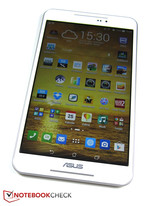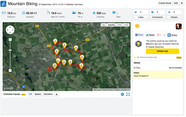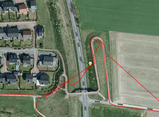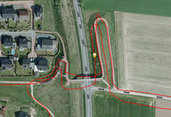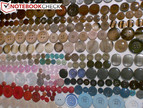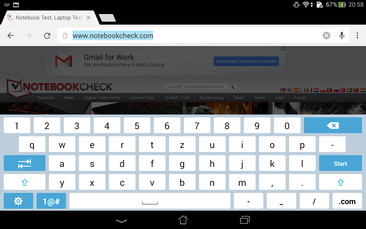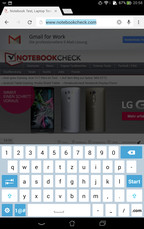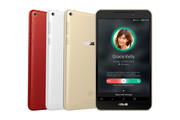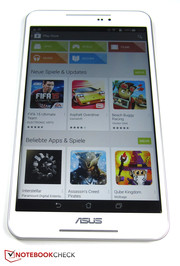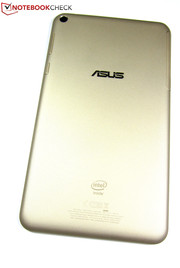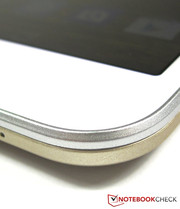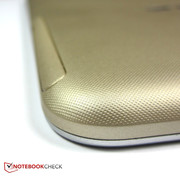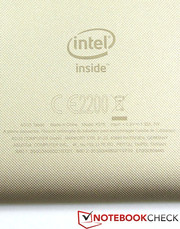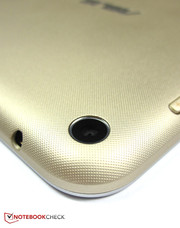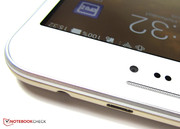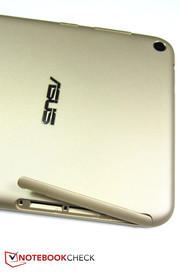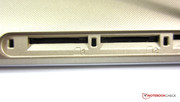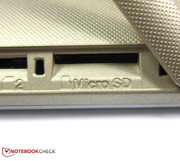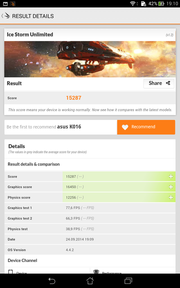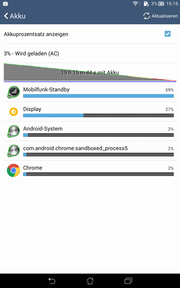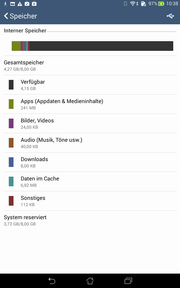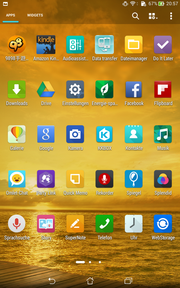Asus Fonepad 8 FE380CG Tablet Review

For the original German review, see here.
After the 7-inch tablet Fonepad 7 FE375CG, Asus now offers an 8-inch version with the Fonepad 8 FE380CG as well. The Fonepad 8 uses Android 4.4.2 and has the same 1280x800 resolution as its smaller sibling. It is also powered by the identical quad-core SoC, the frugal Intel Atom Z3560 with the PowerVR G6430 GPU. You also get 1 GB memory, 8 GB storage as well as two slots for micro-SIM cards. There is also an alternative configuration with 16 GB storage.
So no benefits apart from the bigger display? Not quite, our review shows that the Fonepad 8 FE380CG has a lot more stamina than the Fonepad 7 FE375CG and even stays slightly cooler in operation. Asus did not tell us the price for the tablet yet, even though it was introduced back in June at Computex.
Case
The build quality of the Asus Fonepad 8, which is available with a black, white, red or golden chassis, does not leave anything to be desired. The polycarbonate case of our golden review sample is very sturdy and looks pretty nice as well thanks to the rounded edges and corners. The case can only slightly be depressed and twisted with a lot of force, but there are no creaking sounds. Only the back cover can be pushed in a bit, but not more than by a couple of millimeters. The back cover has a rubberized and profiled surface that is very grippy for the fingers. However, we couldn't notice the anti-fingerprint coating of the display, which is advertised by the manufacturer. The panel quickly attracts dirt and fingerprints just like any other smartphone or tablet.
Connectivity
Asus equips the Fonepad 8 FE380CG with the quad-core SoC Intel Atom Z3560, which enables a fast but also frugal operation of Android. The quad-core processor is supported by the PowerVR G6430 GPU. Around half of the 8 GB storage can be used for your files (4.15 GB). The storage can be expanded by up to 64 GB via micro-SD cards. Besides our 8 GB review sample, Asus also offers the Fonepad 8 with 16 GB storage.
Software
The operating system of the Fonepad 8 FE380CG is Android 4.2.2, which is equipped with Asus' own launcher ZenUI. ZenUI is supposed to improve the handling and offers quick settings, for example, which can be accessed with a swipe gesture from the status bar. Those quick settings give you access to important tablet settings, including WLAN, position and display brightness.
In addition to the OS, several apps are preloaded on the Fonepad 8, including Google apps like Chrome, Maps, Gmail and YouTube besides several tools from Asus. Furthermore, there are apps from Kindle and Facebook as well as the notepad SuperNote, which can be used with finger inputs. The cloud service Asus Webstorage with 5 GB free storage is also on board.
Communication & GPS
The Fonepad 8 FE380CG is also well-equipped in terms of communication. Besides GSM quad-band (850/900/1800/1900 MHz), the Asus supports UMTS quad-band (850/900/1900/2100 MHz). The voice quality was always perfect during our review; it did not matter if we called a landline or another smartphone or took a call. According to the manufacturer, UMTS in combination with HSPA+ is supposed to enable download speeds of up to 42 Mbps. Supported wireless networks of the tablet are 802.11 b/g/n, which worked in our test without any problems and with the expected speed. You also get Bluetooth 4.0 as well as the location services GPS, A-GPS and GLONASS.
As usual, we use the professional navigation device Garmin Edge 500 for a comparison with the review unit. We can see that the Fonepad 8 FE380CG is not always very accurate compared to the reference device from Garmin on our 10-kilometer long bicycle ride. Instead of on the track, we were sometimes in the middle of the forest, in the field or the device would say we were on the highway instead of the crossing bridge. Still, the accuracy of the GPS and GLONASS modules is completely sufficient in practice.
Cameras & Multimedia
The Asus Fonepad 8 FE380CG is equipped with a 5 MP main camera, which can take pictures with up to 2560x1920 pixels and videos in Full HD. The camera module offers surprisingly many features, amongst others an autofocus, a self-timer, facial recognition as well as several picture modes like HDR, Panorama and close-ups. The main camera does not have a photo LED, but it does take decent pictures that are pretty free of picture noise in well-lit environments and convince with natural colors. However, the 2 MP webcam (1600x1200 pixels) disappoints with a poor picture quality.
Accessories & Warranty
The 8-inch tablet comes with a modular power adaptor, a micro-USB cable as well as a quick-start guide. Asus also offers several protective cases for its devices on its website; however, there was no fitting cover for the Fonepad 8 at the time of writing. The review sample has a 24-month warranty.
Input Devices & Handling
Thanks to its quad-core SoC, the Asus Fonepad 8 can convince with very short reaction times and the user really gets the feeling of working with a fast tablet. The first time you will notice the speed is directly after the start. Other tablets often need a couple of seconds before they execute any inputs, but not in this case. The additional number row above the keyboard improves the typing speed because you don't have to switch the keyboard layout. Only drawback: You cannot reach the volume rocker and the power button with your fingers when the tablet lies on a flat surface because of the rounded edges.
Display
The IPS display of the Asus Fonepad 8 has 1280x800 pixels and looks nice thanks to the sharp picture and the vivid colors, just like the smaller sibling Asus Fonepad 7 FE375CG. Looking at other current 8-inch tablets we can see that the resolution is comparatively low. However, this is no drawback for the Fonepad 8; we cannot see any individual pixels in practice. For comparison: While the Huawei MediaPad M1 8.0 has a similarly sized panel like the review unit, the Acer Iconia Tab 8 A1-840FHD has a resolution of 1920x1200 pixels. Both the 7.9-inch Apple iPad Mini Retina (2048x1536 pixels) and the 8.4-inch Samsung Galaxy Tab S 8.4 (2560x1600 pixels) in particular, even though it does have a slightly larger panel, have very sharp panels.
With an average luminance of 351.9 cd/m², the Asus tablet offers a very good result for brightness. The brightness distribution is very even across the whole panel (92%). The low black value of 0.31 cd/m² and the high contrast ratio of 1,165:1 are good results as well; both values can slightly surpass the Asus Fonepad 7 FE375CG, which is based on the same hardware platform.
| |||||||||||||||||||||||||
Brightness Distribution: 92 %
Center on Battery: 361 cd/m²
Contrast: 1165:1 (Black: 0.31 cd/m²)
ΔE ColorChecker Calman: 3.7 | ∀{0.5-29.43 Ø4.78}
ΔE Greyscale Calman: 3.8 | ∀{0.09-98 Ø5}
Gamma: 2.39
CCT: 6872 K
However, a further color analysis of the display with the X-Rite i1Pro 2 colorimeter and CalMAN software reveals some drawbacks. The measurements show that red colors are a bit too weak, while blue colors are too saturated. However, the deviations from the sRGB reference values are still pretty good in ColorChecker (DeltaE of 3.7). The same applies for the grayscale (DeltaE of 3.8). With 6,872 K, the color temperature is close to the optimum of 6,500 K. The slightly suboptimal picture is not noticeable under Android.
Thanks to its bright display, it is no problem to use the Fonepad 8 FE380CG outdoors. Similar to almost every other mobile device, the very glossy display of the Asus affects the readability, but there are hardly any restrictions as long as you don't use the review unit under direct sunlight and look for a place in the shade instead.
Performance
The heart of the Fonepad 8 FE380CG is the quad-core SoC Intel Atom Z3560, which runs with up to 1.83 GHz and is supported by 1 GB memory. The frugal quad-core processor is complemented by the PowerVR G6430 GPU, which is also used in the high-end ARM SoC Apple A7, so we expect a very high graphics performance.
We can actually see very high results of the review unit in the synthetic benchmarks. 3DMark 2013 only gives us a result in the Unlimited setting of the Ice Storm test – the Fonepad 8 is just too fast for the settings Standard and Extreme. In combination with the Acer Iconia Tab, the Asus is at the top of the 3DMark 2013 results. The Asus tablet can clearly surpass the rivals in Epic Citadel and Anomaly 2.
| 3DMark - 1280x720 offscreen Ice Storm Unlimited Score (sort by value) | |
| Asus Fonepad 8 FE380CG | |
| Acer Iconia Tab 8 | |
| Huawei MediaPad M1 8.0 | |
| Samsung Galaxy Tab S 8.4 | |
| Apple iPad mini Retina | |
| Epic Citadel - Ultra High Quality (sort by value) | |
| Asus Fonepad 8 FE380CG | |
| Acer Iconia Tab 8 | |
| Samsung Galaxy Tab S 8.4 | |
| Anomaly 2 Benchmark - High Quality Test (sort by value) | |
| Asus Fonepad 8 FE380CG | |
| Acer Iconia Tab 8 | |
| Huawei MediaPad M1 8.0 | |
| Samsung Galaxy Tab S 8.4 | |
The browser performance of the Fonepad 8, however, falls a bit behind and it is just enough for an average spot. The best device is the Apple iPad Mini Retina.
| Peacekeeper - --- (sort by value) | |
| Asus Fonepad 8 FE380CG | |
| Acer Iconia Tab 8 | |
| Huawei MediaPad M1 8.0 | |
| Samsung Galaxy Tab S 8.4 | |
| Apple iPad mini Retina | |
| Octane V2 - Total Score (sort by value) | |
| Asus Fonepad 8 FE380CG | |
| Acer Iconia Tab 8 | |
| Huawei MediaPad M1 8.0 | |
| Samsung Galaxy Tab S 8.4 | |
| Apple iPad mini Retina | |
| WebXPRT 2013 - Overall (sort by value) | |
| Asus Fonepad 8 FE380CG | |
| Acer Iconia Tab 8 | |
| Samsung Galaxy Tab S 8.4 | |
| Apple iPad mini Retina | |
Write and read transfers are fast on the Asus, sequential and random reads of data in particular. The Fonepad 8 can surpass all the rivals, sometimes by a big margin. It can also keep up well in terms of sequential as well as random writes and secures second place behind the Samsung Galaxy Tab S 8.4.
Gaming Performance
Thanks to its PowerVR G6430 graphics chip, the Asus Fonepad 8 provides high-end performance. All tested Android games, including very GPU demanding titles like Dead Trigger 2 and Real Racing, run completely smoothly.
Emissions
Temperature
Even if you use the maximum performance of the Asus Fonepad 8, it hardly gets warm. During the one-hour stress test, our review unit warmed up to 34.3 °C. All our comparison devices stay similarly cool, for example, the Acer Iconia Tab 8 A1-840FHD and the Huawei MediaPad M1 8.0 that reach 36.6 °C. Only the Samsung Galaxy Tab S 8.4 gets more than lukewarm with 39.1 °C, but that is still a very good value. The thermometer only indicates 31.4 °C for the Asus Fonepad 8 during idle.
(+) The maximum temperature on the upper side is 34.3 °C / 94 F, compared to the average of 33.7 °C / 93 F, ranging from 20.7 to 53.2 °C for the class Tablet.
(+) The bottom heats up to a maximum of 33.8 °C / 93 F, compared to the average of 33.2 °C / 92 F
(+) In idle usage, the average temperature for the upper side is 30 °C / 86 F, compared to the device average of 30 °C / 86 F.
Speaker
The speakers of the Fonepad 8 create a surprisingly powerful stereo sound. As expected, you don't get a bass monster when you buy the Asus. Similar to the majority of mobile devices, the sound is pretty focused on high tones. The scope of supply does not include headphones.
Energy Management
Power Consumption
The Asus Fonepad consumes a moderate 2.3 Watts during idle and up to 5.6 Watts under load. All the competitors except for one device consume much more power, so the battery runtimes should be long. Only the Huawei MediaPad M1 8.0 is similarly frugal amongst the comparison devices (up to 5.1 Watts).
| Off / Standby | |
| Idle | |
| Load |
|
Key:
min: | |
Battery Runtime
Even though the Asus Fonepad 8 has the same battery capacity as its 7-inch sibling Fonepad 7 FE375CG, it manages much longer runtimes in our review. The very realistic WLAN test (display brightness at 150 cd/m² while a script opens a website every 40 seconds) determines a very good runtime of 10:46 hours for the Fonepad 8. This should be more than enough for a standard business day. The Fonepad 7 FE375CG only managed 8:33 hours in this scenario, but that is still better than average in comparison. Only the very frugal Huawei MediaPad M1 8.0 can surpass the review unit amongst the comparison devices with a WLAN runtime of 12:31 hours. The other extreme is the Acer Iconia Tab 8 A1-840FHD that only lasts 6:25 hours before the battery dies.
Verdict
The Asus Fonepad 8 FE380CG convinces with a good overall package. Thanks to the combination of the quad-core SoC Intel Atom Z3560 and the integrated PowerVR G6430 graphics chip, the 8-inch tablet has sufficient performance reserves that no app or game can currently fully utilize. But even if you don't really care about Android games, you will appreciate the performance. The Fonepad 8 is instantly ready after the start and executes inputs without delays. We also liked the good build quality of the tablet with Android 4.4.2, the bright display with wide viewing angles, the long battery runtimes and finally the UMTS module. The 8-inch device is very flexible with 2 slots for SIM cards and quad-band UMTS.
The storage of our 8 GB review unit is limited to around 4.2 GB because of Android and the preloaded apps. If that is not sufficient, you might want to get the 16 GB version of the Fonepad 8 or expand the storage capacity with a micro-SD card (up to 64 GB). It is not a huge drawback that the battery cannot be replaced. However, we cannot find any good words about the poor quality of the webcam. The 5 MP main camera of the Fonepad 8, however, takes nice pictures and Full HD videos.
But there is still the big question: the price. At the time of writing, we don't know what Asus will charge for the Fonepad 8 FE380CG, but the 7-inch sibling Fonepad 7 FE375CG for 200 Euros (~$250) could be an indicator.




